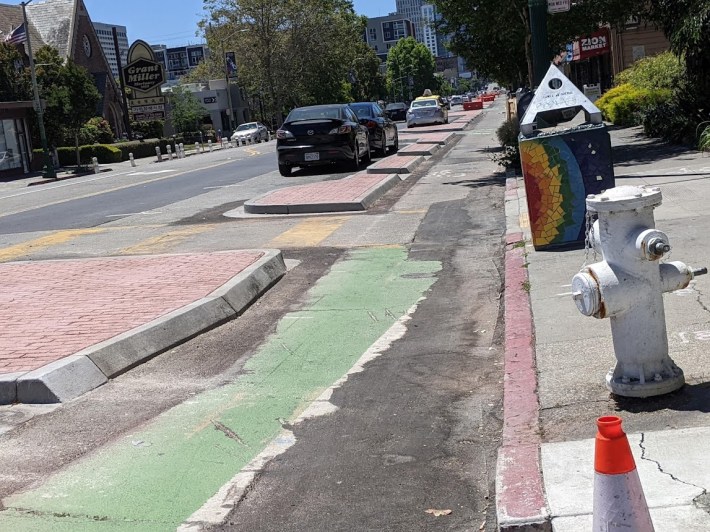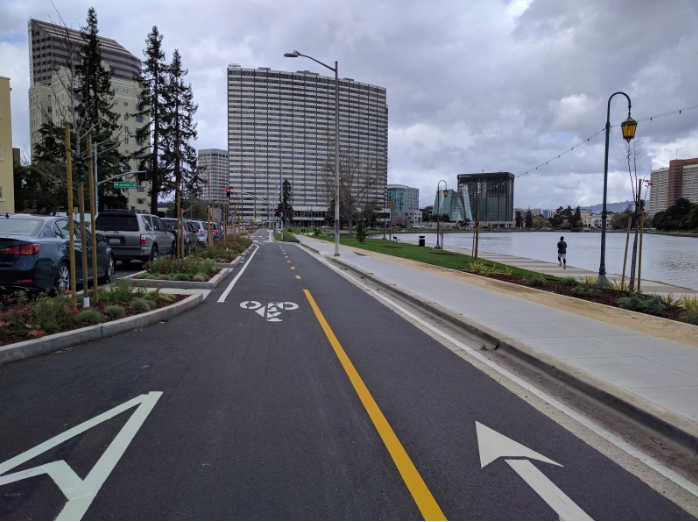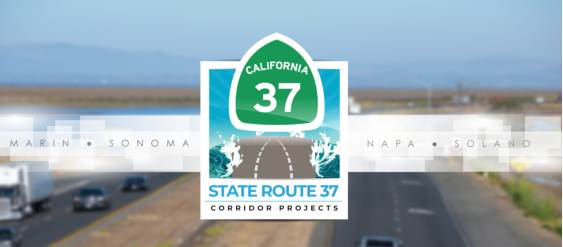Note: GJEL Accident Attorneys regularly sponsors coverage on Streetsblog San Francisco and Streetsblog California. Unless noted in the story, GJEL Accident Attorneys is not consulted for the content or editorial direction of the sponsored content.
Ryan Russo, the first director of Oakland's relatively new Department of Transportation, announced in February that he would be leaving his post and returning to his native New York. The popular leader of OakDOT will be moving to Brooklyn where he will join Together Projects, his wife's consulting business.
Streetsblog caught up with Russo on Thursday at a coffee shop in Latham Square, 500-feet from Oakland City Hall, to hear his reflections on his five years running the department.
***
Streetsblog: Here we are, five years from the interview we did shortly after you started, and things have gone exactly as you would have expected, right?
Ryan Russo: Oh for sure (laughs).
SB: We'll start with a softball. Get in a time machine and go back to 2017. What would you tell yourself, aside from a warning about the pandemic?
RR: First I want to just say, I would do it again. As challenging as it's been, it’s been so rewarding and I’m so grateful. In terms of advice, I probably had a sense of this coming in, but it was even more so in retrospect. This work is about people, not places and things. The stripes, the signs, and the crosswalks--no, it’s about the planners, the engineers, and the staff and community members. It's about being able to connect with and work with and collaborate with those people, whether it's the mayor, the city council, or a long-overlooked neighborhood. It's the only way you make any progress.
SB: It doesn't seem as if much progress has been made, at least not this past week. Jonathan Waters was killed by a motorist on Shattuck. And Emily Martinez was killed by a motorist while crossing International.
RR: The task of creating safe streets is a job still to be completed. There are a lot of disturbing trends at this moment in Oakland and cities around the country--in a lot of public policy areas--but in traffic safety in particular. But we have failed, we are in a backsliding moment. And I think for OakDOT and for the city of Oakland moving forward with all the challenges that the city’s facing, be it homelessness, affordable housing, or public safety, the spotlight has to stay on these issues. I’m proud of the fact that we’ve worked really hard to be data-driven, evidence-based, and values infused, in the allocation of limited resources to solve problems. But what we’ve been doing; more needs done.
SB: Emily Martinez was killed in the crosswalk. International remains notorious for traffic violence despite so much investment. Why has it been so hard to fix?
RR: Bus Rapid Transit added 30 new traffic signals for safe crossings, but we still see folks making choices that change lives and end lives. Reckless driving has become an epidemic in the post-COVID era. We’re seeing a breakdown in social cohesiveness in a lot of different areas. And there's a reticence to have accountability measures.
SB: Such as?
RR: OakDOT has been a champion for Automated Speed Enforcement, which is right in line with the desire to reduce armed police interactions. Yet so far we haven’t been able to get that passed at the state. We haven’t even been able to get our local bicycle advocacy group to support it.
SB: Bike East Bay. And CalWalks opposed it, based on equity grounds. I mean, I get the concern, but if you get police out of the mix and it turns out there's a disproportionate number of violations among people of color, well, okay, you need to look at that. But the evidence shows they work to reduce speeding and save lives. That's why Walk San Francisco is a co-sponsor.
RR: Right.
SB: Speaking of advocates, Bike East Bay's Robert Prinz pointed out something from our interview in 2017 about the planned protected intersection at Grand and Lakeside. You said at the time that "We just won the grant so it’s typically two to three years from design to construction." Here we are in 2022 and nothing’s happened. And that intersection is nuts. Why hasn’t OakDOT blocked off the slip turn and mixing zone?
RR: Capital project delivery remains a challenge. Great plans get on the boards but then you get into emergency services, utilities, the underground issues. But as an industry, we need to be better at reforming our processes and our systems. You also need to accommodate the right turn geometrically in the through lane.
SB: Yeah, but, you can put a barrier in and close that hairy slip turn while that's being sorted.
RR: I can’t say I’ve looked at it in detail. I think there’s a reconfiguration of the corner, either way a right-turning vehicle is going to cross paths with a cyclist going straight, so you're just moving the conflict.
SB: To a place where it will be much slower.
RR: But it still needs to be designed.
SB: Berkeley closed a slip turn at Adeline and Russell, near Ashby BART. They put two bollards in. Doesn't really seem that challenging.
RR: There’s a request-driven element for this. It hasn’t been clamored for. Not that we’re just going to respond for what’s been clamored for. But we’re also going to use crash history. Striping plastic, posts, signs--those are limited resources that are in incredibly high demand. We've been bringing hardened centerlines to Oakland--first city in the west to do that. And traffic circles. We’re piloting them to discourage people from doing doughnuts. That’s been a top priority of the council and they have good traffic calming benefits. We're prioritizing traffic calming in neighborhoods that haven’t seen it. But yes, it isn't happening everywhere at once.
SB: I get the resource issue. But I'm also seeing a hell of a lot of repaving going on with the bike stripes going in right where they were, when protected bike lanes could have been created.
RR: I would say that streets are being done differently. There's a ton of upgrades, but it’s not across the board. We adopted a policy that all crosswalks put back after paving must be high visibility crosswalks, versus the old two-line crosswalk. That might not be sexy for a Streetsblog reader, but they’re actually quite good and they're simple to upgrade.
SB: Of course, our readers support that, but what's the point in putting painted door-zone lanes right back where they were? They're just used as double-parking zones. You know that.
RR: To redo the geometry of where vehicles park--to flip the parking lane and the bike lane--requires a significant amount of design resources. You have to establish new sight-lines at intersections. And if there’s going to be a change, there’s got to be significant community engagement. Not every street that gets repaved can get planning design and engineering.
SB: But you also advocated for undoing the protected bike lanes on Telegraph in the KONO. I'm not sure how that fits into your "design and engineering" resource argument, considering the paint-and-post-protected bike lanes and the designs were already in place.
RR: Councilmember Lynette Gibson McElhaney in the summer of 2020, moved and got the whole council to do a significant reassessment of the plan before concrete was poured. They wanted us to measure twice before we cut and there had been deep frustrations and some safety concerns related to the pilot configuration.

SB: But she was out by that point. Carroll Fife was in and she supported protected bike lanes there. And you were arguing for unprotected lanes.
RR: No, we made tremendous progress. We achieved something we didn’t have—clarity from the city council.
SB: So you were pushing the city council for clarity? Well, you got that. Unanimous approval. So then what happened between 29th and MacArthur, where it reverts to unprotected bike lanes? It doesn't make much sense to have protected lanes in Temescal and KONO but then it reverts for the middle section to unprotected lane. Just yesterday, by the way, I had to go around three cars parked on the bike lane in that gap.
RR: The context changes. The land uses change.
SB: Really?
RR: It's a little more suburban density. And the freeway overpass is a big factor. We're struggling with homelessness in this city.
SB: You figured the encampment under the overpass would take over the bike lane if it was protected?
RR: Yes, and it’s dark and you’d be hemmed in behind a row of cars. We did some public engagement around the time of the Temescal final decision and heard mixed things. And some of the lessons from the KONO told us it could cause problems in the middle section.
SB: I think maybe it's time for another softball. What's your proudest accomplishment? The Lakeside Drive/Harrison cycle track I'd imagine.
RR: Certainly.
SB: It's my couple of minutes of heaven when I'm riding around Oakland. I divert my ride just to get on it.

RR: It's not just how it turned out, but also the process.
SB: Because it almost didn't happen?
RR: The improvements around the lake were funded by a water quality measure, DD. It was potentially a real missed opportunity. The OakDOT team cooperated with public works, made some hard choices, risked some grant funding, but the city council accepted our recommendation to pivot.
SB: Right, because there wasn't going to be a protected bike lane before you intervened.
RR: It was risky, but now I think it’s California's best urban bike path.
SB: Absolutely. Except for the slip turn at the end, but we've covered that.
RR: And it's not long enough.
SB: Right. No argument there. Now, I'd be remiss if I didn't ask you about your most famous accomplishment, Slow Streets. You basically started a national movement during the pandemic.
RR: For sure, that's one of our proudest achievements. Government is inherently risk-averse. Advocates were saying, COVID's happening and we need to shut down streets to give people room. But this was way more than a Cyclovia or a summer-streets proposal. The health department was saying it had to be big to spread everyone out. And when it’s big and it’s 24/7, it’s unrealistic to think you could just close streets. Recycling needs to be collected, Amazon deliveries need to come and essential workers need to be able to go, so you couldn’t close the streets completely.
SB: So you do access-only.
RR: We did a minor intervention with construction barricades. And we did it on a large scale so it isn't just downtown or near the lake. So I’m proud we acted ambitiously and quickly and that risk was determined to be acceptable. And that families were comfortable with, for example, a three-year-old on a scooter coming down the street at the same time as a recycling truck.
SB: You still had push back though.
RR: And I'm proud we listened to the feedback. People in priority equity communities said this is not the thing we need at this time. We were transparent about that. I could have said 74 percent of Oaklanders like Slow Streets, which was true, but the breakdown by income and race told a much more nuanced story. So we created "Essential Places," where we said let's help people who are still riding the bus.
SB: But much of all that has been rolled back.
RR: We were maintaining 21 miles of Slow Streets. And while it looked as if the signs never moved, actually they would get destroyed and it would take time and money to replace them.
SB: So you did a tactical retreat?
RR: It was the right thing to do with our limited resources. We have a backlog of speed bump installations, we see all this reckless driving and crashes going up. The council’s priority is to prevent sideshows by installing rubber bumps.
SB: Will Slow Streets return?
RR: It’s hard to say because of all the overtime spent putting barricades back. It got fanfare, but bottom line is Oaklanders are deeply frustrated by the conditions of the streets and sidewalks. As Janette Sadik-Khan used to say in New York, you can’t do the fun stuff if you don’t take care of the basics. We live in a city where an 85-year-old grandmother who has lived on the same street her whole life has never seen a paving truck.
SB: Anything else?
RR: This is an important moment for local government and for government in general. Vacancies exist and there's a labor shortage. We’ve got the foundations of great systems for distributing limited resources. We have to look at contracting and delivering capital projects with an eye toward streamlining and better effectiveness. If I had the magic wand, I would make changes to civil service. I need engineers here. I need a plan for hiring. The way you get those things like protected bike lanes is you develop a plan for hiring. That's what you need your next transportation director to work on.
This Q&A was edited.
***
For more on OakDOT's progress, check out this just-released five-year update.






